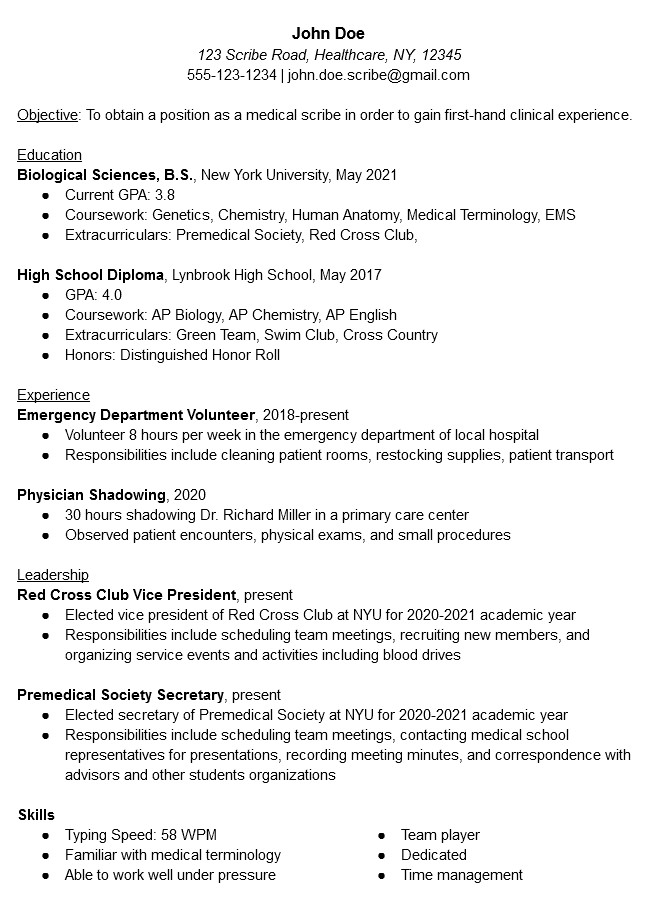A resume is essentially a summary of your experiences. Whether you are applying for a medical scribe job or healthcare graduate school, you will be asked to submit a resume with your application. Recruiters and admissions counselors who sift through hundreds to thousands of applicants often rely on your medical scribe resume to get a quick overview of your background to determine whether they should consider the rest of your application.
This article will review the different parts of a medical scribe resume and explain what to include in each.
How to Write a Medical Scribe Resume in 6 Steps
Step 1: Personal Information
The first thing to include in your resume is your name and contact information. Just below your name, it is good to list a few ways you can be reached – an address, a phone number, and an email are recommended. Make sure you keep an eye out for mail, phone calls, and emails for several weeks after you apply, as scribe recruiters may contact you later on as existing scribes leave their positions.
Step 2: Objective
A resume often includes a one to two sentence statement explaining the reason for the application. When applying for a medical scribe position, you may wish to include your motivation for becoming a medical scribe. For example: “Objective: To obtain a position as a medical scribe at [hospital] to gain clinical experience and develop a better understanding of the healthcare field.
Below is an example scribe resume for application to medical scribe jobs.

Step 3: Education
If you are a student or recent graduate, your formal education should be the first section of your resume. You should list your education in order from most recent to least recent. While the only education required for a medical scribe position is a high school diploma or equivalent, more competitive applicants have some college education, preferably with a medically-related major. This is not required, but it shows a dedication to the field of medicine, and a desire to learn more about it and gain clinical experience.
When listing your education, be sure to include relevant information for each school, such as field of study (if applicable), date the degree was earned or is expected, GPA, extracurricular activities, and any coursework that is relevant to the job you are applying for. Coursework relevant to medical scribing may include biology and chemistry courses, medical terminology courses, healthcare administration courses, psychology courses, and any other classes that may help you better perform your job as a scribe.
Step 4: Experience
The next section of your resume should be experience. If you have been out of school for several years, then it may make sense to list this section before Education. This section may include work experience, volunteering, shadowing, research, and community service. If you have a lot of experience in these areas, you may consider making each its own section. For example, if you have a few previous jobs as well as considerable research experience, you could make one section for “Work Experience” and one section for “Research Experience”.
These sections can be organized either chronologically from most recent to least recent, or in order of relevancy. Each experience should be accompanied by details such as the date you completed the experience, the associated organization or company (if applicable), the location, and a few bullet points describing your responsibilities.
Any experience that shows dedication to the field of medicine is good to show on an application for a scribe position. This may include volunteering in a hospital or clinic, shadowing providers, doing community service, or service activities with extracurricular student organizations.
Step 5: Certifications
Many people have earned certifications outside of school, so they do not exactly belong in the education section of the resume. If this is the case for you, these can be listed in a separate section, including the name/title of the certification, date the certificate was earned, and a brief description of how it was earned and/or what qualifications it gives.
A certificate received for completing a medical scribe training course is an excellent item to list on your resume when applying for a scribe position. Completing a ER scribe training course before even applying shows a great dedication and desire to learn. Even if you will be trained upon hiring, having prior training will make it much easier to keep ahead of the curve once you are in the clinic. A medical scribe training certificate shows scribe recruiters that you already have a lot of the knowledge you will need to be an efficient scribe and that you are enthusiastic about gaining experience in the healthcare field.
Step 6: Hospital scribe Skills
At the bottom of your resume, you can list some skills that may help you in your role as a scribe. One skill that is typically expected from scribe applicants is a fast typing speed. Providers will often dictate their thoughts and findings to their scribes, so it is important to be able to keep up with their pace without missing important details. A speed of at least 55 WPM is recommended.
The ability to work calmly in a fast-paced environment is also a good quality in a scribe. Particularly if you are planning on hospital scribing in an emergency department, there are often many things happening at once. You will have to keep track of multiple patient charts at a time, keep an eye on lab and imaging results as they come in, and be ready for the next patient encounter at all times. It is not uncommon for emergency physicians to drop what they are doing to meet a patient as soon as they are brought out of the ambulance, so you will have to be ready to follow. Even scribes in other specialties will be expected to keep up with the pace of their provider and quickly adapt to any unexpected situations.
When working as a hospital scribe, you will be a part of a healthcare team. You are only directly assisting your provider, but you may often communicate with nurses, technicians, and other providers throughout a shift. For this reason, the ability to work as a part of a team is also a key skill for scribes to have.
Take some time to reflect on the things that you can do well, characteristics that would make you a good employee and a good scribe, and list them in this section.
Medical Scribe Resume Examples
While the information in your resume is important, how your resume looks may arguably be more important. The visual appearance of your resume is the first impression it makes on the reader. Among hundreds of polished and professional resumes, a sloppy resume is more likely to be overlooked or dismissed, regardless of the content. There are many resume templates online and word processors. If you follow an example medical scribe template, be sure to choose one that is sleek and professional, without too many distractions such as bright colors. Stick to one, easy-to-read font and make sure everything appears neatly on the page. In general, a resume should not be longer than one page as it is meant to be a very brief description of your history. It should be written in first person implied voice, meaning written from a first-person perspective but omitting personal pronouns. Good luck!

